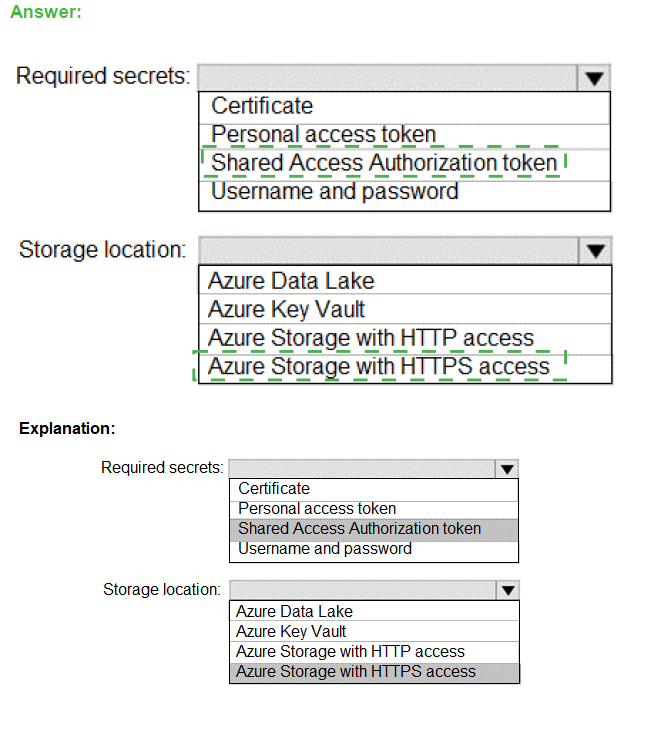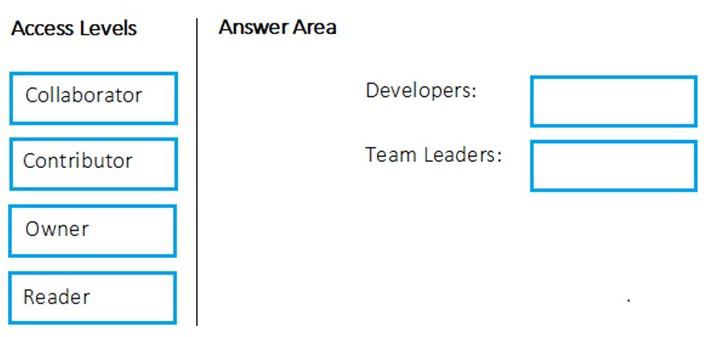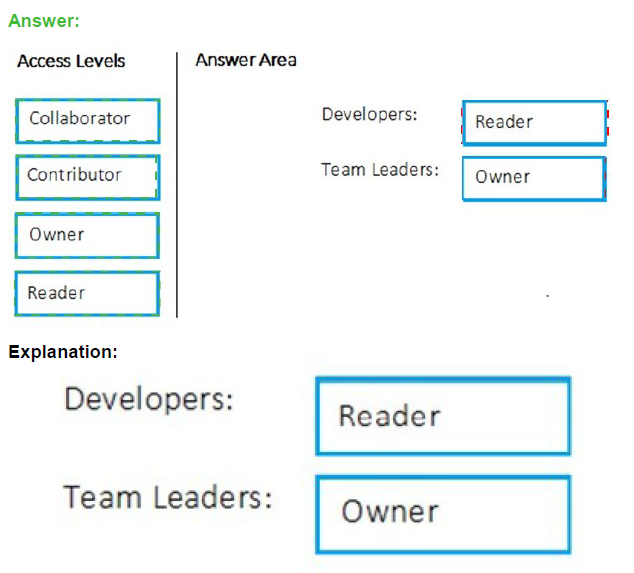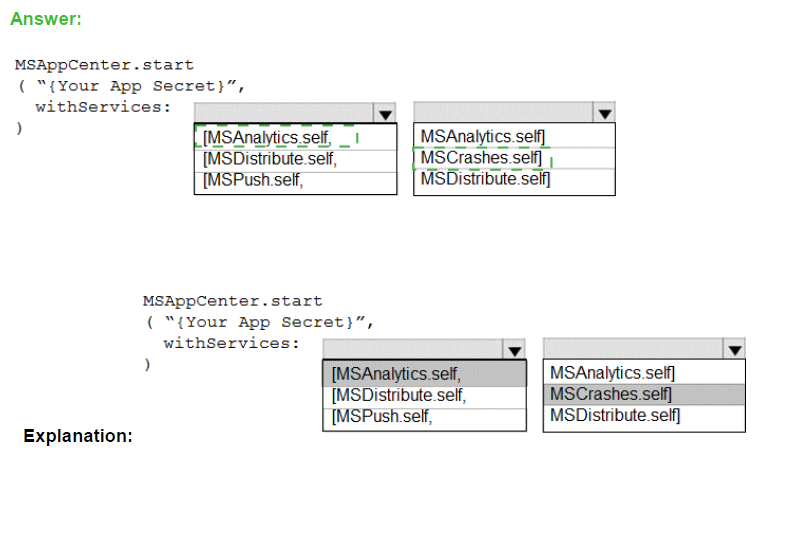Topic 1: Litware inc. Case Study: 1
Overview
Existing Environment
Litware, Inc. an independent software vendor (ISV) Litware has a main office and five
branch offices.
Application Architecture
The company’ s primary application is a single monolithic retirement fund management
system based on ASP.NE T web forms that use logic written in V8.NET. Some new
sections of the application are written in C#.
Variations of the application are created for individual customers. Currently, there are more
than 80 have code branches in the application’s code base.
The application was developed by using Microsoft Visual Studio. Source code is stored in
Team Foundation Server (TFS) in the main office. The branch offices access of the source
code by using TFS proxy servers.
Architectural Issues
Litware focuses on writing new code for customers. No resources are provided to refactor
or remove existing code. Changes to the code base take a long time, AS dependencies are
not obvious to individual developers.
Merge operations of the code often take months and involve many developers. Code
merging frequently introduces bugs that are difficult to locate and resolve.
Customers report that ownership costs of the retirement fund management system
increase continually. The need to merge unrelated code makes even minor code changes
expensive.
Requirements
Planned Changes
Litware plans to develop a new suite of applications for investment planning. The
investment planning Applications will require only minor integration with the easting
retirement fund management system.
The investment planning applications suite will include one multi-tier web application and
two iOS mobile applications. One mobile application will be used by employees; the other
will be used by customers.
Litware plans to move to a more agile development methodology. Shared code will be
extracted into a series of package.
Litware has started an internal cloud transformation process and plans to use cloud based
services whenever suitable.
Litware wants to become proactive m detecting failures, rather than always waning for
customer bug reports.
Technical Requirements
The company's investment planning applications suite must meet the following technical
requirements:
• New incoming connections through the firewall must be minimized.
• Members of a group named Developers must be able to install packages.
• The principle of least privilege must be used for all permission assignments
• A branching strategy that supports developing new functionality in isolation must be used.
• Members of a group named Team leaders must be able to create new packages and edit the permissions of package feeds
• Visual Studio App Center must be used to centralize the reporting of mobile application
crashes and device types in use.
• By default, all App Center must be used to centralize the reporting of mobile application
crashes and device types in use.
• Code quality and release quality are critical. During release, deployments must not
proceed between stages if any active bugs are logged against the release.
• The mobile applications must be able to call the share pricing service of the existing
retirement fund management system. Until the system is upgraded, the service will only
support basic authentication over HUPS.
• The required operating system configuration tor the test servers changes weekly. Azure
Automation State Configuration must be used to ensure that the operating system on each
test servers configured the same way when the servers are created and checked
periodically.
Current Technical
The test servers are configured correctly when first deployed, but they experience
configuration drift over time. Azure Automation State Configuration fails to correct the
configurations.
Azure Automation State Configuration nodes are registered by using the following
command.

You need to configure a cloud service to store the secrets required by the mobile applications to call the share.
What should you include in the solution? To answer, select the appropriate options m the answer area, NOTE: Each correct selection is worth one point.


Every request made against a storage service must be authorized, unless the request is for a blob or container resource that has been made available for public or signed access. One option for authorizing a request is by using Shared Key.
Scenario: The mobile applications must be able to call the share pricing service of the existing retirement fund management system. Until the system is upgraded, the service will only support basic authentication over HTTPS.
The investment planning applications suite will include one multi-tier web application and two iOS mobile application. One mobile application will be used by employees; the other will be used by customers.
Which package feed access levels should be assigned to the Developers and Team Leaders groups for the investment planning applications suite? To answer, drag the appropriate access levels to the correct groups. Each access level may be used once, more than once, or not at all. You may need to drag the split bar between panes or scroll to view content.

NOTE: Each correct selection is worth one point.

Box 1: Reader
Members of a group named Developers must be able to install packages.
Feeds have four levels of access: Owners, Contributors, Collaborators, and Readers. Owners can add any type of identity-individuals, teams, and groups-to any access level.
Box 2: Owner
Members of a group named Team Leaders must be able to create new packages and edit the permissions of package feeds.
You have a project in Azure DevOps.
You plan to deploy a self-hosted agent by using an unattended configuration script.
Which two values should you define in the configuration script? Each correct answer presents part of the solution.
NOTE: Each correct selection is worth one point.
A. authorization credentials
B. the project name
C. the deployment group name
D. the organization URL
E. the agent pool name
Note: This question is part of a series of questions that present the same scenario. Each
question in the series contains a unique solution that might meet the stated goals. Some question sets might have more than one correct solution, while others might not have a
correct solution.
After you answer a question in this section, you will NOT be able to return to it. As a result,
these questions will not appear in the review screen.
You plan to create a release pipeline that will deploy Azure resources by using Azure
Resource Manager templates. The release pipeline will create the following resources:
A. Yes
B. No
You have an Azure DevOps organization named Contoso. You need to receive Microsoft Teams notifications when work items are updated. What should you do?
A. From Azure DevOps. configure a service hook subscription.
B. From Microsoft Teams, configure a connector.
C. From Microsoft Teams, add a channel.
D. From Azure DevOps. install an extension.
E. From the Microsoft Teams admin center configure external access.
You have Azure Pipelines and GitHub integrated as a source code repository. The build pipeline has continuous integration enabled.
You plan to trigger an automated build whenever code changes are committed to the repository.
You need to ensure that the system will wait until a build completes before queuing another build.
What should you implement?
A. path filters
B. batch changes
C. scheduled builds
D. branch filters
Explanation:
Batching CI runs
If you have many team members uploading changes often, you may want to reduce the number of runs you start. If you set batch to true, when a pipeline is running, the system waits until the run is completed, then starts another run with all changes that have not yet been built.
Example:
# specific branch build with batching trigger:
batch: true branches:
include:
- master
To clarify this example, let us say that a push A to master caused the above pipeline to run. While that pipeline is running, additional pushes B and C occur into the repository. These updates do not start new independent runs immediately. But after the first run is completed, all pushes until that point of time are batched together and a new run is started.
You have an Azure DevOps project named Project1 and an Azure subscription named
Sub1. Sub1 contains an Azure virtual machine scale set named VMSS1. VMSS1 hosts a
web application named
WebApp1. WebApp1 uses state full sessions.
The WebApp1 installation is managed by using the Custom Script extension. The script
resides in an Azure Storage account named sa1.
You plan to make a minor change to a UI element of WebApp1 and to gather user
feedback about the change.
You need to implement limited user testing for the new version of WebApp1 on VMSS1.
Which three actions should you perform? Each correct answer presents part of the
solution.
NOTE: Each correct selection is worth one point.
A. Modify the load balancer settings of VMSS1.
B. Redeploy VMSS1.
C. Upload a custom script file to sa1.
D. Modify the Custom Script extension settings of VMSS1.
E. Update the configuration of a virtual machine in VMSS1.
To resolve the current technical issue, what should you do to the Register- AzureRmAutomationDscNode command?
A. Change the value of the ConfigurationMode parameter.
B. Replace the Register-AzureRmAutomationDscNode cmdlet with Register-AzureRmAutomationScheduledRunbook
C. Add the AllowModuleOverwrite parameter.
D. Add the DefaultProfile parameter.
Explanation:
Change the ConfigurationMode parameter from ApplyOnly to ApplyAndAutocorrect.
The Register-AzureRmAutomationDscNode cmdlet registers an Azure virtual machine as an APS Desired State Configuration (DSC) node in an Azure Automation account.
Scenario: Current Technical Issue
The test servers are configured correctly when first deployed, but they experience configuration drift over time. Azure Automation State Configuration fails to correct the configurations.
Azure Automation State Configuration nodes are registered by using the following command.

Note: This Question Is part of a series of questions that present the same scenario. Each
question in the series contains a unique solution that might meet the stated goals. Some
question sets might have more than one correct solution, while others might not have a correct solution.
After you answer a question in this section, you will NOT be able to return to ft. As a result,
these questions will not appear in the review screen.
A. Yes
B. No
How should you complete the code to initialize App Center in the mobile application? To answer, select the appropriate options in the answer area.
NOTE: Each correct selection a worth one point.


Scenario: Visual Studio App Center must be used to centralize the reporting of mobile application crashes and device types in use.
In order to use App Center, you need to opt in to the service(s) that you want to use, meaning by default no services are started and you will have to explicitly call each of them when starting the SDK.
Insert the following line to start the SDK in your app's App Delete class in the didFinishLaunchingWithOptions method.
MSAppCenter.start("{Your App Secret}", withServices: [MSAnalytics.self, MSCrashes.self])
You need to recommend an integration strategy for the build process of a Java application.
The solution must meet the following requirements:
A. Yes
B. No
To run your jobs, you'll need at least one agent. A Linux agent can build and deploy different kinds of apps, including Java and Android apps. If your pipelines are in Azure Pipelines and a Microsoft-hosted agent meets your needs, you can skip setting up a private Linux agent. The Azure Pipelines agent pool offers several virtual machine images to choose from, each including a broad range of tools and software. We support Ubuntu, Red Hat, and CentOS.
You manage code by using GitHub. You need to ensure that repository owners are notified if a new vulnerable dependency or malware is found in their repository. What should you do?
A. Configure branch protection rules for each repository.
B. Configure Dependabot alerts.
C. Configure CodeQL scanning actions.
D. Subscribe all the repository owners to the GitHub Advisory Database.
| Page 4 out of 41 Pages |
| Previous |